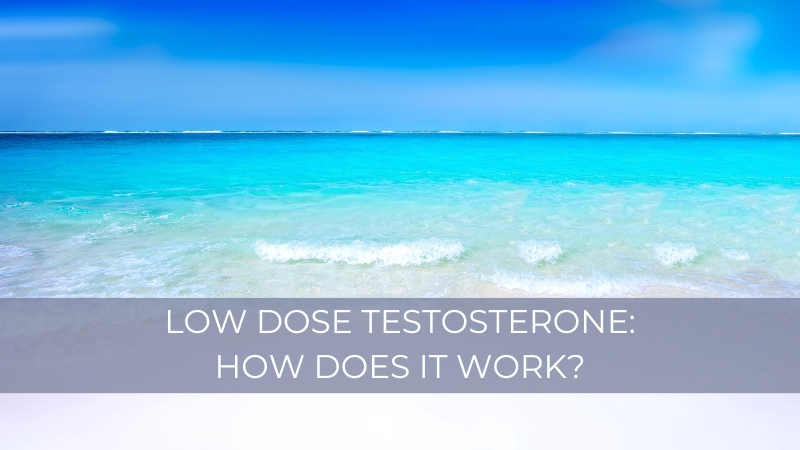For some trans and nonbinary people, hormone therapy is an important aspect of gender affirmation. Testosterone is commonly used in gender-affirming hormone therapy (also known as HRT) for those who want to masculinize their bodies. While high doses of testosterone are often associated with significant physical changes, low dose testosterone therapy can also be an effective way to achieve a more masculine appearance at a more gradual pace. Some people take low dose testosterone for a period of time until they achieve their desired physical changes, then discontinue the medication. Many misconceptions and myths surround testosterone gender-affirming hormone therapy. In this blog post, we will explore the physical effects of low dose testosterone and address common misconceptions.

Hi, I’m Rey, a nonbinary writer! Please subscribe for more stories and resources:
Content is for informational purposes only and is not medical advice. I am not a medical professional and shall not be held liable for any use of this content. Please consult your doctor.
What are the physical effects of taking low dose testosterone?
If you take low dose testosterone (assuming your body is not already producing a lot of testosterone), you will gradually start to look, sound, and feel more masculine. The physical effects of taking low dose testosterone can vary somewhat from person to person (for example, if you have the genetics for baldness, that may affect your results). The effects may include:
- Lower voice due to vocal cord thickening
- Increased facial and body hair
- Redistribution of fat from your hips to your belly and other places
- Bottom growth (you know, down there)
- Increased or different sexual interest
- More oily hair and skin
- More sweat that smells differently
- Coarser hair texture
- More angular face due to fat redistribution (your bones won’t change)
- Chest shrinkage which may make it easier to wear a binder (but not a big decrease in size! nothing but top surgery will remove much)
- Receding hairline or pattern baldness
The difference between low dose and standard dose is how fast these changes occur. The same changes will occur over months vs. weeks, or years vs. months. This comes with a big caveat: your results may vary. Everyone’s body is different and the same hormones will cause different results in different people.

Is microdosing the same as low dose?
Yes, microdosing is pretty much the same as low dose, as far as I can tell. Both refer to taking less than a standard dose of gender-affirming hormone therapy to achieve slower results intentionally.
You can use either gel (applied to the skin) or injections to microdose or take low dose testosterone. Gel is an easier option to start with for many people, although it has a risk of unwanted skin-to-skin transfer (if you have a partner who runs on estrogen, for example).
What if I don’t want facial hair or baldness?
If you’re interested in some of the effects of testosterone gender-affirming hormone therapy, but not the hair-related effects, you may be able to work around that. Ask your medical professional about taking DHT blockers to reduce beard growth and pattern baldness.
(Misconception) Am I going to become “ugly” if I take testosterone?
We are not “boy-haters” here, okay! I appreciate masculine traits and appearance. Many people do. You may find you look somewhat less like a conventionally-attractive cis woman. For many of us, that is the whole point of gender-affirming changes.
Testosterone- or estrogen-dominant traits are morally neutral. You are not a “better” or “worse” person based on the hormones in your body.
People who object strongly to someone’s transmasculine transition may be scared because they use the gender binary to control that person. “Ugly” may be another way to say “you’re not wearing the clothes and putting on the appearance of someone I think I can control and that bothers me.”
What you think of your appearance and how you wish to present yourself to the world is most important.

(Misconception) Is testosterone gender-affirming hormone therapy the same as taking steroids for bodybuilders?
No, it is not. (“But it’s the same, or similar chemicals,” you protest.) Yes, but the dosage is crucial. Think about it: everyone has some amount of testosterone in their body, including cis women. Some cis women don’t produce enough testosterone and take hormone replacement therapy to get to their correct level. This is not the same as transitioning because the dosage is relatively low.
The effects of testosterone are pretty different between cis women and cis men, right? It all depends on the amount. Similarly, if a bodybuilder takes a mega-dose of testosterone, that’s also very different. Low dose testosterone will not give you bodybuilder-type results, because the levels are so much lower.
(Misconception) Will I get so angry I start punching strangers?
This depends on your personality (and morals) a lot more than it does on the hormones in your body. If you’re the kind of person who goes to the bar (or the MMA gym) to punch people, yeah, T is probably going to encourage that tendency a bit. Your muscles may strengthen so you’ll have a stronger punch. To be clear, I don’t recommend getting on T to win barfights. I recommend getting on T and joining a martial arts gym to help work out your aggression in a healthy way for yourself and others. 🙂
But if you’re a pacifist who is concerned about developing a sudden tendency to attack people, I wouldn’t worry about it. Gender-affirming hormone therapy is, ideally, putting your body back into alignment. If you don’t already have uncontrolled anger, you won’t develop it by taking a low dose of testosterone.
To put it into perspective, if you start on a low dose of testosterone, you will still have less testosterone in your body than most cis men. This is nowhere near the amount needed to give you “roid rage.”
Anecdotally, gender-affirming hormone therapy can cause emotional changes, and changes in the way we process emotions. People taking testosterone may find they are less inclined to cry, and the reverse for people taking estrogen. Some people appreciate being able to feel clearer, stronger emotions like anger and sadness without dissociating so much from gender dysphoria.

Am I still a valid trans person if I don’t take hormones (or stop taking hormones)?
Yes, absolutely!! Especially, if it feels right to you. Some trans people aren’t able to use gender-affirming hormone therapy because of medical conditions, side effects, the cost of treatment, lack of insurance, not liking the effects, etc. Some trans people simply do not wish to use hormone therapy. This is all valid, and does not make you any less trans.
Some people choose to take testosterone for a limited time, until they observe the physical changes they want, then stop taking the medication.
How do I know if gender-affirming hormone therapy is right for me?
If you don’t know for sure, I recommend continuing to think about it, talk about it, and research the effects. One of the best ways to become familiar with gender-affirming hormone therapy is to search for videos or blogs of people talking about their experiences. Online trans communities can be a great resource for information.
If you’re absolutely sure, but scared, this is normal, I think. Keep in mind you are in control of the process. You can decide whether to fill the prescription or not. You can decide whether you want each individual squirt of gel on your skin or each injection. If it doesn’t work for you, you can stop. You can start again later (or not).
This blog post attempts to correct some of the common misconceptions surrounding low dose testosterone. By exploring the physical effects of gender-affirming hormone therapy, I hope you have gained a better understanding of what to expect from this treatment. It is important to respect and support those who choose hormone therapy as part of their gender affirmation journey. Thank you for reading and learning about this aspect of gender diversity.

Thank you for this explanation and commentary.
I enjoy your writing and I enjoy your nature videos. Very calming!
Thanks very much! I appreciate you reading the post and watching the videos and for your kind feedback.